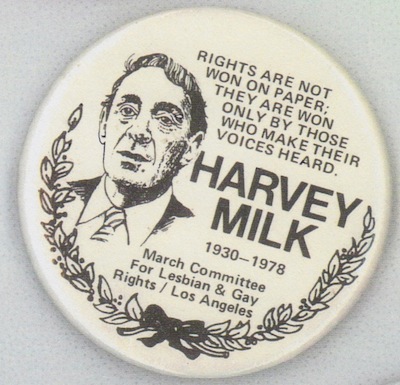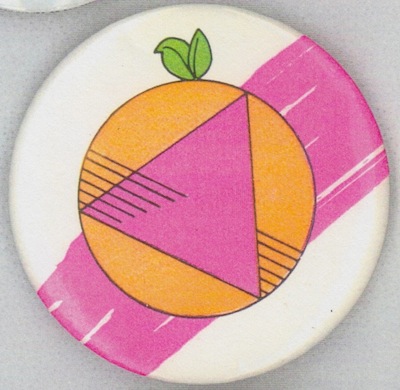This button is from 1978 and the infamous Proposition 6, which was proposed by a state senator from my hometown of Fullerton, CA named John Briggs. This dubious proposition would have made it legal for public schools to fire teachers for being gay. Thankfully, it was defeated.
This button is from the Califia Community, a long-running Los Angeles-based grassroots alternative education group. Launched in 1975, the Califia Community challenged mainstream ideas of "feminism." It attracted women from a range of gender expressions, sexual orientations, class backgrounds, and races or ethnicities.
In 1979, one year after the asassination of gay rights icon Harvey Milk, the first National March of Washington for Lesbian and Gay Rights was organized. It drew between 75,000 and 125,000 gay men, lesbians, bisexual and transgender people and straight allies to demand equal civil rights and urge the passage of protective civil rights legislation.
In 1986, failed politician Lyndon LaRouche and his supporters got Proposition 64 on the California Ballot, which would have given the government the power to quarantine people with AIDS. It failed, and two years later LaRouche was sentenced to 15 years in prison for mail fraud.
The NAMES Project was conceived by LGBT activist Cleve Jones, who was a close friend of Harvey Milk. It's a massive quilt, the largest piece of folk art in the world, and each square is dedicated to someone who has died of AIDS. It was created during the height of the AIDS epidemic, in 1987, to raise awareness, and prompt legislative action.
In 1987, a second March on Washington for Lesbian and Gay Rights was organized. It was prompted by the AIDS crisis, the Reagan administration's lack of acknowledgement of the crisis, and the Supreme Court of the United States ruling in Bowers v. Hardwick upholding the criminalization of sodomy between two consenting men in the privacy of a home.
AIDS Walk Orange County was started in 1987 by local activists to raise awareness and money to help people afflicted with AIDS. This year, I participated in AIDS Walk for the first time.
In the early 90s, employees of Disneyland formed the Lesbian and Gay United Employees (or LEAGUE). Although it is located in conservative Orange County, Disneyland has been (unofficially) a pretty gay-friendly employer, at least since the 90s.
Some of the buttons are not tied to a particular event, but rather contain symbols which have become important to the LGBT community. The pink triangle featured below has a significant history. It was originally used as a mark of shame in Nazi Germany for homosexuals in concentration camps. As with the cross for Christians, a symbol of suffering has been transformed into a symbol of hope and dignity.
OC Pride!
The lambda symbol in the center of the button below is another symbol of gay rights. It signifies unity under oppression. The Lambda Legal Defense and Education Fund focuses on civil rights of LGBT people.
The rainbow flag was designed by Gilbert Baker for the 1978 San Francisco Gay Freedom Celebration. It represents the diversity of gays and lesbians around the world.


















